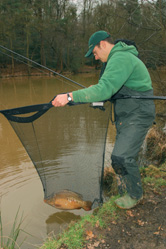Fish lecturer Simon Scott travels to Roost Hole Lake to demonstrate why simple rigs are often best…
SIMON Scott is one of the country’s leading authorities on fish. There are few people in the land that know more about fish and fish behaviour than he does! Whether you’re talking tope or trout, sea bass or silver bream, he’s the man who can explain how they live, how they feed and – even more importantly – how you catch them.
Fortunately for us, Simon’s speciality is carp and here Simon will explain a bit about the rig he uses on the majority of carp waters. Now, seeing as he’s at the cutting edge of carp fishing, you might expect that rig to be something totally revolutionary, something that would hook every single carp that ever picked it up.
But you’d be wrong. Instead, as we found out when we visited Simon at Horsham Angling Club’s Roost Hole Lake in West Sussex, for the vast majority of his fishing he prefers to use something that revolves around the simple knotless knot, a length of Snake-Bite and a lead that quite frankly looks like it has seen better days!
Getting Riggy
“Rigs are not the be-all and end-all of carp fishing,” said Simon as he sat under his brolly, waiting for a bite on a freezing cold February day.
“Beginners and more experienced carp anglers alike often think that they need to use the latest, complicated, all-singing all-dancing rig if they’re going to catch anything. But nothing could be further from the truth. As long as your rig has a sharp hook tied onto it, with a good bait on the hair, and as long as its mechanics are sound, you’ll catch fish. You don’t need a complicated rig!”
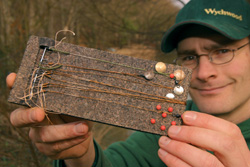 |
| Simon likes to keep all his rigs neat and organised on a rig board |
So the big question then – what rig does Simon like to use for the majority of his carp fishing, and why?
“Well, the rig I’ve got on today is the rig I use on most of the waters I fish,” he said. “It incorporates a Snake-Bite Gold hook link with a small, semi-fixed lead and a Drennan Boilie hook that’s been tied onto the Snake-Bite with a knotless knot.”
Surely that can’t be it? But it is! Simon reels one of his rods in ready for a recast and shows us exactly what he has tied onto the business end. We find, to our astonishment, a hinged Snake-Bite rig with a semi-fixed lead and Boilie hook with a new Ocean Fresh fishmeal freezer bait attached to the hair!
“It might look simple, and it is simple to tie,” said Simon, “but there are still some very useful hints and tips I can pass on that will increase your catch rate no end.
“These tips involve fine tuning your rig and making sure it’s performing to its maximum potential. Even with a so-called simple rig like a knotless knot, there are little things you can be doing that will ensure you hook more and land more carp.”
Knotless Secrets
As we have found out, Simon’s hook is tied to the Snake-Bite with the knotless knot.
Surely that’s all there is to say on that subject. But you’d be wrong if you thought that.
“I took a dozen of my students out fishing for a day at RMC Angling’s Burghfield Match Lake last week,” Simon said. “I asked them, ‘who knows how to tie the knotless knot properly’? and they all put up their hands. ‘We’ve seen it in the magazines’, they said.
“I then asked them to tie some rigs up using the knotless knot. The resulting rigs weren’t of the best quality! One lad even said that, although he could tie the knot, he kept losing fish on it because it kept snapping.
“I asked him to tie a knotless knot for me, and he did. The mistake he was making occurred when he was whipping the hair to the shank – the first whip he was making was going the wrong way.
“I had to explain to him that the first whip you make is vital. If you have a look at the eye on any hook, you’ll see that there’s often a gap between the eye and the shank itself. Also, one side of the eye can be a bit rough and sharp edged.
“The problem my student was having was that the eyes on his hooks had a really rough finish on one side. The first whip he was making of the knotless knot took the hook link over that rough edge, which meant that all the pressure during the fight was exerted on that part of the knot. As a result, the hook link snapped because it was rubbing against the sharp bit of the eye.
“But the lad said he was only losing some of his fish. Well, every now and then he was tying the knotless knot correctly. Unbeknown to him, sometimes he was tying it so the first whipping was away from the rough join between the shank and the eye. This meant that the pressure on the knot was on a smooth part of metal, so there was no danger of the hook link snapping.
“Small details like this can make all the difference in rig tying, and will ensure you have a rig that will perform to its maximum potential in all circumstances.”
The Hair
Simon also ties on his hair in a different way to most anglers who use the knotless knot. Instead of tying the hair loop before he ties the hook on, which is what most top carpers advocate so they can judge the exact length their hairs should be, Simon ties the hook onto a 16-inch length of Snake-Bite that’s completely undoctored. It hasn’t had any of its outer coating stripped off at all. This leaves a long, stiff hair that hasn’t got a loop in it.
At this stage of the tying process Simon peels back the outer coating of the Snake-Bite on the hair. He then ties a loop in it, making the length of the hair to suit the size of bait he wants to use. This then leaves a totally supple hair.
“The supple hair is for two reasons,” said Simon. “Firstly, it doesn’t damage the bait when I thread it on. Secondly, I think that a rig with a supple hair is harder for a pricked fish to successfully get rid of than a rig that has a stiff hair.
“Think of it like this. When a fish takes your hook bait into its mouth, and the hook successfully pricks its bottom lip, it might then try to blow the rig out of its mouth in an attempt to dislodge the hook.
“From watching a lot of carp feed, a rig with a stiff hair is less of an advantage because the carp can actually use the stiff nature of the hair to help them get rid of the hook. You’d be surprised just how often carp are successful in doing just that!”
The Hinge
The hair isn’t the only part of Simon’s rig that is supple. Two centimetres or so down the hook link from the hook, he also peels back another section of outer core to create a hinge. This hinge is about 1cm long, but what is it for?
“When you create the hinge,” Simon said, “you are leaving a stiff section of hook link just below the hook. This, in effect, extends the hook’s shank. Such an extension gives your rig more chance of finding a hook hold in a carp’s mouth – especially when used with the hinge, which allows the hook to turn more efficiently. This increases your chances of converting what we call a pick-up (when the carp takes a bait into its mouth) into a proper take.
“A lot of beginners don’t realise this, but some carp – particularly those that live in waters where they are pressured by anglers all year round – become adept at successfully ejecting rigs. Understanding how your rig works and making fine adjustments to it, like the supple hair and the hinge, can definitely help you get more bites.”
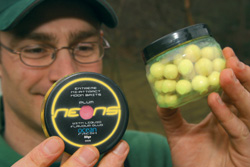 |
| Pineapple Neons accounted for the only carp of the trip |
Pop-ups And Lead Weights
A question that many readers might ask is whether Simon’s rig is designed for pop-ups or bottom baits.
“You can use it for either,” advised Simon, “though I do favour it for pop-up presentations.
“When using pop-ups I mould a small amount of putty beneath the hinge. This putty holds firm on the Snake-Bite. I add enough to sink the bait slowly, as I don’t like a pop-up that’s critically balanced (where it only just sinks). Neither do I like a pop-up that’s weighted down too heavily – I don’t want the pop-up so over-weighted that the fish has to work hard just to suck it into its mouth!”
Lead Arrangements
It is obvious that, even on a rig that’s seemingly simple and easy to tie, Simon has put a lot of thought into how it all works in practice. The same can be said of his lead arrangements, which look remarkably simple as well – though are devastatingly effective at what they’re designed to do.
Simon uses two types of lead. The first constitutes a semi-fixed swivel lead that sits on a two-inch length of 2mm ESP silicone tube; the second is a simple in-line lead set-up without any tubing.
“The in-line lead is used exclusively on very hard lake beds,” said Simon. “I feel that in-line leads are better at pulling the hook home when a
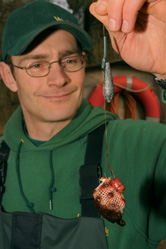 |
| A PVA bag was used to deposit freebies tightly around the hook bait |
carp has pricked itself and moves off with the hook and hook bait in its mouth.
“However, I would never advise using an in-line lead on a soft bottom, or in silt. This is because, when an in-line lead sinks through the water, it can alight on the lake bed and then sink into the silt – pulling the hook link into the silt too.
“This will leave a section of Snake-Bite sticking out of the silt at a very strange angle, rendering your presentation far less effective. It also makes the presence of a rig far more obvious to wary carp.
“The semi-fixed swivel lead on the silicone tube is far better for fishing in silt,” continued Simon. “Here the lead sinks through the water, landing on its point. The lead can then sink a small way into the silt without pulling the hook link with it, allowing the Snake-Bite to lie almost flat on the lake bed. This will therefore give a much more effective presentation.
“So to sum up, on hard bottoms use in-line leads, and in weed and silt use a semi-fixed lead on a length of 2mm silicone tubing. Both set-ups are very safe. The in-line lead is free running, with the swivel lead able to come off the silicone tubing easily if it needs to.”
“I also use lead clips from time to time, but that – along with the use of tubing and lead core – is a subject I will examine in a future issue of Total Carp.”
Ice Carp
After he’d finished demonstrating his rig to us, Simon threaded another hook bait onto it and flicked it back out into Roost Hole’s depths. The water at this popular club lake is very coloured, because it has so many fish in it; which explains why Simon’s lead isn’t coated.
“On a lake like this it will make no difference at all whether you use a lead that’s camouflaged or a lead that looks a bit rough and silvery, like mine,” said Simon. “However, on clear waters, again where the carp are pressured, I prefer to use a lead that blends in well with the lake bed!”
As if to prove a point, half an hour after he’d cast out the rig he’d been showing us, Simon had a storming run on it and proceeded to land a cracking looking double-figure mirror – and this with half the lake still being frozen solid after a heavy overnight frost!
The hook hold the Snake-Bite rig had found in the carp’s mouth was as solid as a rock, with the hook being buried deep in the corner of the bottom lip. The pop-up the carp had fallen for, an Ocean Fresh Neon Pineapple bait, had been taken confidently and was well back inside the mouth when the fish was landed.
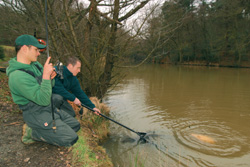 |
| Success… To catch from a half-frozen lake was testament to the effectiveness of Simon’s rig |
Proof!
“That shows that my rig works,” laughed Simon as he unhooked the fish. “I hope that I’ve demonstrated that, even though I’d consider this rig to be quite simple in its mechanics and in terms of how easy it is to tie, thinking a bit about how your rig works can result in more carp being put on the bank.
“Rigs are an important part of the carp fisherman’s armoury. Even if you use a simple rig, start to think about how you can fine tune it. Then you might well find that you start to get more bites this year.
“However, you must also remember that rigs aren’t the only key to success! As I said at the beginning of this article, you must still use a decent bait – and you must still cast your rig to a spot where carp are present and prepared to feed. It doesn’t matter how good your rig is. If you’re not fishing anywhere near carp, you won’t catch a thing!”


